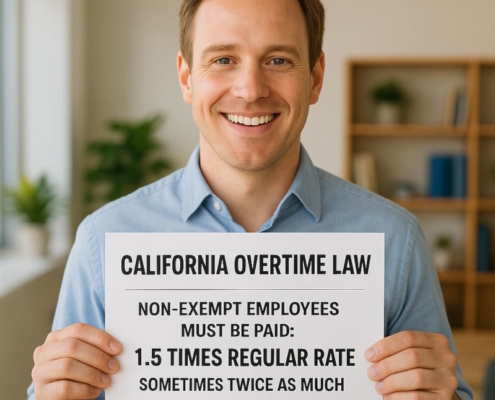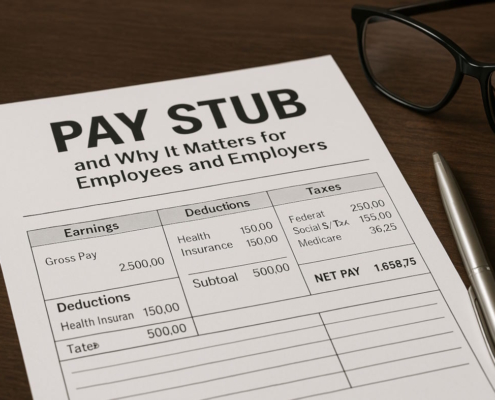Employment Law Articles
Learn and discover the latest useful employment law articles for practical information, DIY, and ideas from a network of leading business and corporate lawyers.
Learn more about: Business | Corporate | Employment

New Hire Forms Checklist: Required Documents & Onboarding Essentials for Employers
Manage new hire onboarding smoothly using this checklist of required federal, state, and internal employment documents. Meet compliance needs and simplify hiring by collecting tax forms, offer letters, benefits paperwork, and signed policy acknowledgments.

Comp Day Explained: Eligibility, Benefits, and How to Calculate It Correctly
Comp day lets eligible employees take time off instead of receiving overtime pay, offering flexibility in work schedules. This article explains how comp time is calculated, who qualifies, and the differences between comp time and overtime rules.

Work Permit California: Requirements, Age Limits, and Job Restrictions for Minors
Minors in California need a work permit to get jobs, with specific restrictions based on age, role, and school status. This article outlines age requirements, job limitations, working hours, and exceptions to the state’s work permit rules for minors.

Split Shift Meaning Explained: How It Works, Benefits, Laws, and Real-World Examples
Split shifts divide a workday into separate periods with a long unpaid break, boosting flexibility and reducing staffing costs. This schedule helps businesses meet demand during peak hours while supporting employee well-being and complying with labor laws.

Is California an At-Will State? 4 Key Exceptions You Need to Know
California permits at-will employment, but specific exceptions restrict when employers may legally terminate an employee without explanation. Contracts, public policy, fraud, and fairness-based exceptions can provide legal grounds for challenging terminations.

California Pay Data Reporting: 2025 Deadline, New MENA Category, and Updated Filing Requirements
The 2025 deadline for California pay data reporting brings updated requirements, including MENA classification and new employer obligations. Covered employers must submit demographic wage data by job role, gender, race, and pay band or face financial penalties.

Family Leave California: Paid Family Leave Benefits, Eligibility, and Updates for 2025
California’s Paid Family Leave program provides up to eight weeks of partial wage coverage for caregiving and bonding with children. Eligibility criteria and compensation limits have changed for 2025, administered through the State Disability Insurance (SDI) system.

California Child Labor Laws: Key Rules About Work Permits, Hours, and Restrictions for Minors
California sets strict rules on work permits, hours, and job types allowed for minors under its child labor laws. State and federal rules also limit dangerous tasks and require school attendance for working minors.

California Minimum Wage Increase 2025: New Rates for State, Fast Food, Healthcare, and Localities
California’s 2025 minimum wage increase sets new statewide, fast food, healthcare, and local rates employers must comply with. Exempt and industry-specific employees face new salary thresholds, impacting wage standards across sectors and jurisdictions.

Background Check California: Laws, What Shows Up, and How to Clear Your Record
California background checks show criminal history, credit data, education records, and other public details under strict screening laws. Options such as expungement, pardons, and record sealing may remove damaging entries from your personal background file.

How Many Hours Can a Minor Work in California? A Complete Guide to Labor Laws and Restrictions
Minors working in California must follow strict hour limits based on age, school attendance, and job category. Employers who violate labor rules risk significant fines and possible criminal consequences.

California Overtime Law: Rules, Exemptions, Pay Rates, and Worker Rights Explained
California overtime law requires non-exempt workers to receive extra pay for working beyond daily and weekly hour limits. Certain employees, including independent contractors and exempt workers, do not qualify for overtime based on legal standards.

How to Calculate Overtime in California: Daily, Weekly, and Double Time Pay Explained
California overtime laws require daily and weekly overtime pay for nonexempt workers, including salaried, commissioned, and piece-rate employees. This guide outlines calculating overtime, daily double time, regular pay rates, and employer responsibilities without addressing alternative workweek schedules.

What is Comp Time for PTO? A Complete Guide for Employers and Employees
Employers and employees can use comp time for PTO if it is applied legally with clear policies in place. Comp time rules differ between public and private sectors, affecting when it can substitute for overtime pay.

No Tax on Overtime in California: 2025 Policy Updates, Exemption Timeline, and What Workers Should Expect
California may introduce a 2025 overtime tax exemption, but no confirmed start date or final state legislation exists yet. Workers and employers await Sacramento’s decision on removing state taxes from overtime earnings under the proposed changes.

Minimum Wage in California 2025: State and City Rates Explained
The minimum wage in California will rise to $16.50 per hour in 2025, with some local rates set even higher. Employers must follow state, city, and industry-specific wage regulations carefully to remain compliant and avoid penalties.

California Fast Food Minimum Wage 2025: Statewide and Local Updates
The California fast food minimum wage will rise to $20 per hour in April 2025, affecting many workers statewide. Local minimum wage rates also vary across California cities, with some surpassing the new state baseline.

How old do you have to be to work? Age limits explained
Minimum age requirements for work depend on federal, state, and job-specific rules that focus on young workers' safety and rights. Teens can start working at 14, but restrictions remain in place until 18, depending on the specific type of job.

Workplace Culture and Hostile Work Environments in California: Your Rights and Legal Options
Employees facing hostile workplaces in California have legal protections to address harassment, discrimination, and toxic work environments. Protect your rights, report misconduct, and pursue action through California's Civil Rights Department or with legal support.

What Is a Pay Stub and Why It Matters for Employees and Employers
Pay stubs detail wages, deductions, and taxes, helping employees track earnings and employers comply with state payroll regulations. They support loan applications, reduce payroll disputes, and are required or regulated in many states across the U.S.

What Are the Proper Steps to Fire Someone in California?
Terminating an employee in California requires following legal guidelines, maintaining professionalism, and ensuring proper documentation. This guide outlines lawful termination reasons, key procedural steps, and best practices to reduce legal and financial risks.

How Long Does a Misdemeanor Stay on Your Record in California?
A misdemeanor conviction in California stays on public record indefinitely but may be eligible for expungement under specific conditions. Background checks typically show misdemeanor convictions for seven years, but expungement can remove them from most employment screenings.

How Do I Prepare a Script for Firing Someone?
Learn the professional steps for firing an employee, from preparing a script to handling emotional reactions. Understand the proper procedures, reasons, and communication techniques to ensure a smooth and respectful termination.

What Is Involved in a PAGA Lawsuit?
PAGA lawsuits allow employees to file claims for labor code violations on behalf of themselves and others in California. Employers can face significant penalties, prompting many to settle to avoid costly judgments.

What Are the Rules for 10-Minute Breaks?
California law mandates two paid 10-minute breaks and a 30-minute unpaid meal break for an eight-hour shift. Employers who fail to provide required breaks may face penalties, and employees can seek legal action for compensation.

Can I Work Six Hours Without a Lunch Break?
California law requires a 30-minute meal break for shifts over five hours, but employees can waive it if working exactly six hours. Employers must comply with strict labor laws, ensuring uninterrupted meal breaks and legal protections for workers.

What Can I Do If My Employer Didn’t Pay Me on Payday?
Employers in California must pay workers on time, or they may face penalties of up to 30 days' wages for delays. Employees can file wage claims, seek legal assistance, or report violations to the California Labor Commissioner's Office for unpaid wages.

What Qualifies as a Hostile Work Environment in California?
Employees in California facing severe or persistent harassment based on protected traits may have legal options under state and federal laws. Filing a complaint with the California Civil Rights Department or consulting an employment attorney can help protect workplace rights and seek compensation.

When Is a Doctor’s Note for Work Required in California?
California employers generally cannot demand a doctor's note for sick leave, but exceptions exist under specific laws and circumstances. Legal conflicts persist, and employers may require medical documentation for disability accommodations, FMLA leave, or other valid reasons.

What Does California Law Say About Final Paycheck Rules?
California law mandates that final paychecks be provided promptly, with termination pay due immediately and resignation pay within 72 hours. Employers must include all owed wages, expenses, and accrued benefits, with penalties for late or incomplete payments.
16,628
